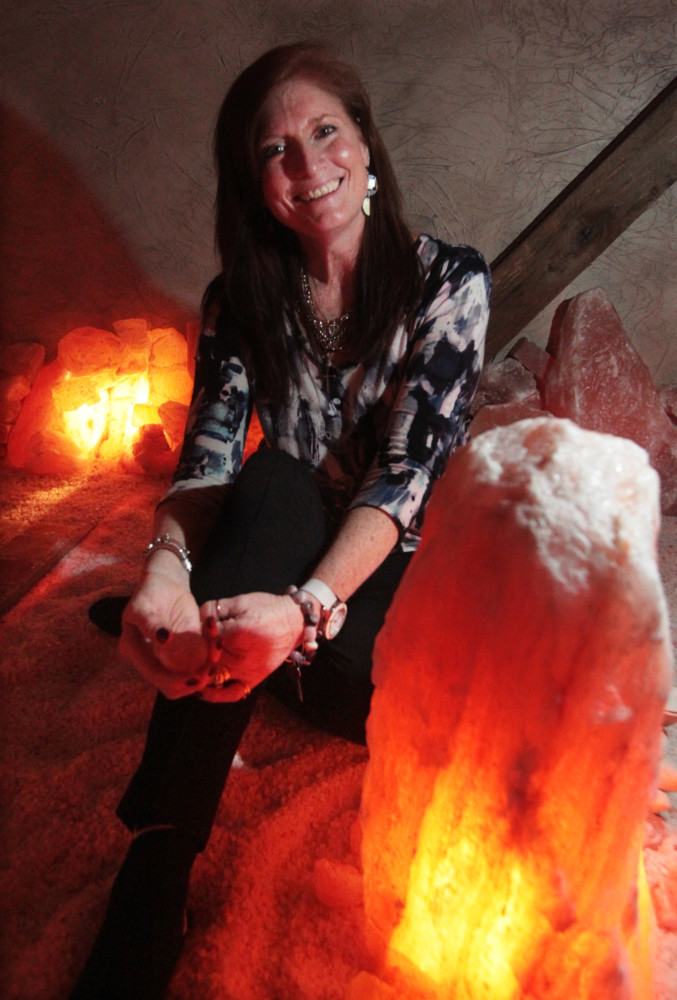By Mary Beth Breckenridge
Akron Beacon Journal
WWR Article Summary (tl;dr) The theory behind a “Salt Cave” is that Himalayan salt contains the same minerals as our bodies and is therefore supposed to help the body achieve a healthy balance. While little research has been done to prove the therapeutic effects of salt caves, some scientists are open-minded about the possibilities.
PLAIN TOWNSHIP, Ohio
You know how good it feels to breathe the ocean’s salt air?
That’s what Barbara Addessi-Hostetler wants clients of her Cave-ation salt cave to experience.
The cave isn’t really a natural formation, but rather a room filled with Himalayan salt crystals. Spending time inside the tranquil environment is supposed to ease a number of physical ailments, from respiratory problems and arthritis to skin conditions and digestive issues.
Whether that’s true has yet to be proved scientifically. But there’s little debate about the good feeling that comes from spending 45 uninterrupted minutes reclining in the orangy glow of lighted crystals, soothed by the sounds of bird song and New Age music.
It’s like a mini-vacation in a suburban strip mall, which is exactly how Addessi-Hostetler came up with the Cave-ation name.
The room is dimly lighted, with peach-colored salt crystals covering the floor and larger rocks of salt lined up around the perimeter, perched on shelves and clustered beneath a mantel to give the effect of a fireplace. Many of the larger rocks are lighted from inside, producing a soft glow like firelight.
Strings of miniature white lights wrapped in burlap crisscross the high ceiling, and an indoor fountain trickles in one corner.
Two reclining chairs flank the mantel, with blankets available in case the 68- to 70-degree air starts to feel chilly. A brick pad just inside the door provides a firm surface for customers using wheelchairs or walkers, so they can experience the salt cave without having to negotiate the crystal-covered floor.
Before entering the cave, customers can remove their shoes and put on disposable booties so their feet are in close contact with the salt and its purported healing properties. Once inside, they have the options of holding salt crystals in their hands and applying bags of salt to problem areas.
And then they just relax. Some meditate or pray, Addessi-Hostetler said. Some chat if they’re with someone else. Some fall asleep, mostly men, she said.
Customers are asked not to take electronic devices into the salt cave. A book is OK, but most of the time “it’s on the floor when I come in” at the end of the session, she said.
Customers can use the cave alone or in small groups. Four people can fit comfortably at one time, but Addessi-Hostetler has accommodated as many as seven.
Addessi-Hostetler was introduced to the concept during a trip to Asheville, N.C. A rainstorm kept her from a hike she’d planned, so she went looking for something else to do and discovered a salt cave.
She figures it was divine intervention.
Before that cave visit, Addessi-Hostetler was already interested in the use of salt therapy for skin conditions and had been making lamps out of salt crystals. She was so captivated by the salt cave experience that she wanted to open her own in Northeast Ohio.
She pitched the idea to Cindy Reutter, owner of the alternative health center Rising Sun Holistic Choices, and Reutter embraced the idea.
The 8-by-11-foot cave was built by Addessi-Hostetler’s husband, Steve, who accented the room with rustic barn wood. The wood was provided by Reutter’s father-in-law, who reclaimed it from a family farm and donated it in memory of his late wife.
The theory behind the cave is that Himalayan salt contains the same minerals as our bodies and is therefore supposed to help the body achieve a healthy balance.
While little research has been done to prove the therapeutic effects of salt caves, some scientists are open-minded about the possibilities.
An article on the American Lung Association’s website, for example, refers to theories that inhaling salt particles kills microorganisms in the lungs, reduces inflammation and thins mucus. The association said salt caves might help people with obstructive lung diseases feel better, although it urged people with lung ailments to discuss salt therapy with their doctors.
Addessi-Hostetler said clients have reported improvement in conditions including allergies, breathing difficulties and a deep skin cut, and she has experienced relief from her own foot pain caused by fallen arches. She said the results depend on how regularly the clients continue salt therapy at home.
“Of course, no guarantees,” she said, “but the testimonies are just a blessing. I’m bringing this to people to help.”














































































































































































































































































































































































